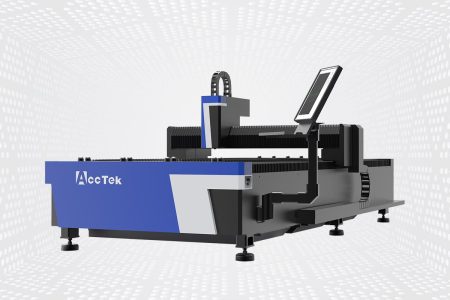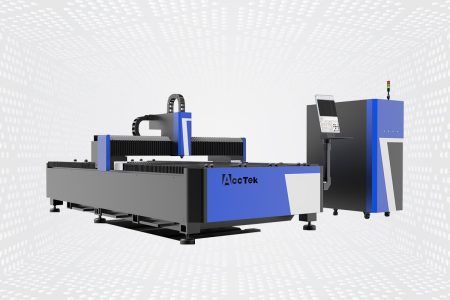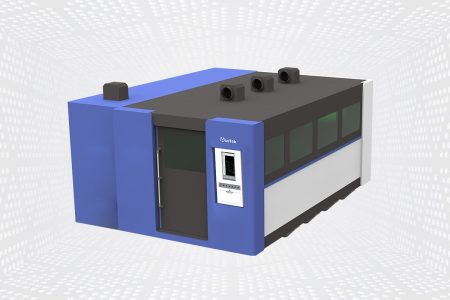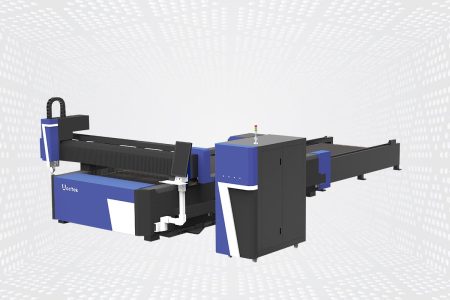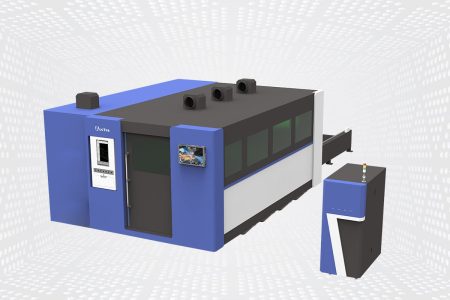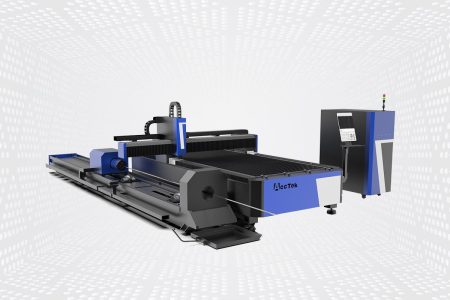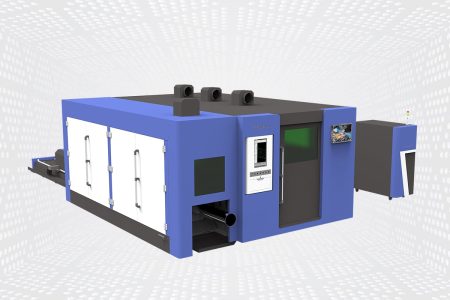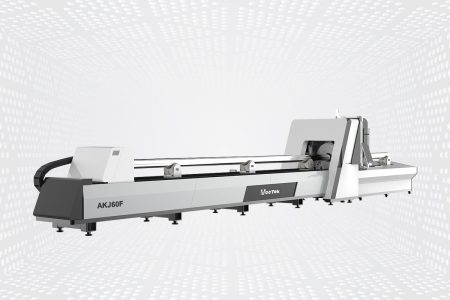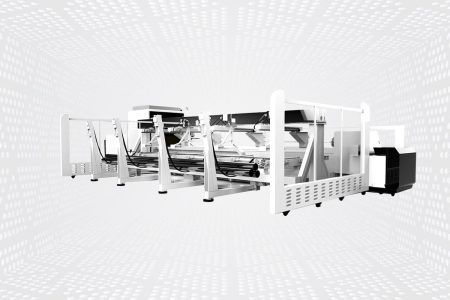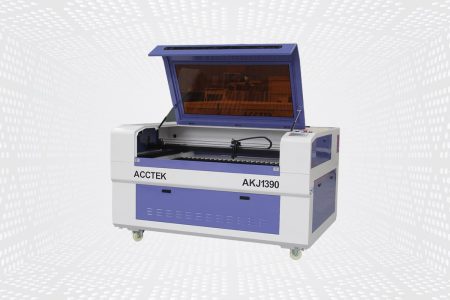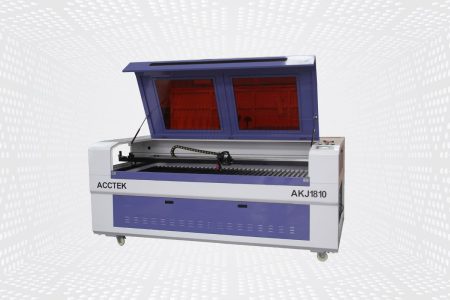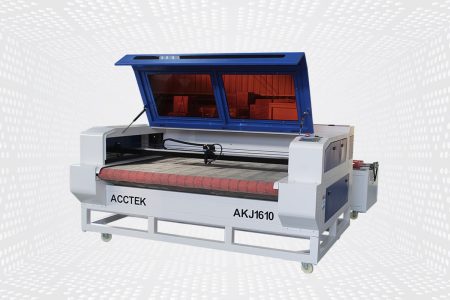年保証
0
注文
0
+
Machine Models
0
+
AccTek レーザー切断機
レーザー切断機は、集束光線を使用してさまざまな材料を切断する特殊なツールです。レーザーで材料を切断するプロセスはレーザー切断と呼ばれ、さまざまな製造および産業用途で使用されています。このプロセスは非常に正確であるため、レーザー切断機は複雑な形状や複雑なデザインを高精度で切断できます。レーザー切断機は、最も用途が広く手頃な価格の金属加工ワークピースの 1 つになりました。レーザー切断機は、レーザービームと補助ガスのみを使用して、さまざまな厚さの金属および非金属材料を切断できます。レーザー切断機は、金属と非金属の優れたエッジ仕上げと驚異的な切断速度を提供します。 AccTek のレーザー切断機には、金属または非金属加工のニーズに合わせて、完全に密閉された保護カバーとサイズを含むがこれらに限定されない幅広い標準オプションがあります。
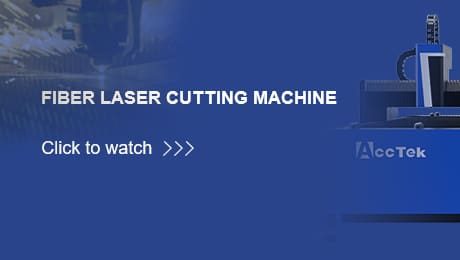
についてのビデオを再生 ファイバーレーザー切断機

についてのビデオを再生 CO2レーザー切断機
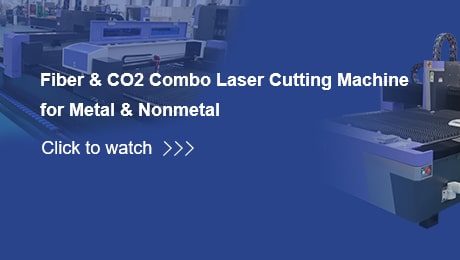
についてのビデオを再生 ファイバーと CO2 レーザー切断機
ファイバーレーザー切断機は、高出力のレーザービームを使用してさまざまな材料を切断する最先端のタイプのレーザー切断機です。ファイバーレーザー切断機は、ステンレス鋼、アルミニウム、銅などの金属だけでなく、プラスチック、複合材、その他の材料も簡単に切断できます。ファイバーレーザー切断機は、非常に効率的で強力な光源であるファイバーレーザージェネレーターによって駆動されます。他のタイプのレーザー切断機と比較して、ファイバーレーザー切断機は、より高い精度と速度でより厚い材料を切断できます。さらに、ファイバーレーザー切断機はメンテナンスが比較的簡単で、幅広い用途に使用できます。
CO2 レーザー切断機は、最も一般的なタイプのレーザー切断機です。それらは、ファイバーレーザージェネレーターほど強力ではないCO2レーザージェネレーターによって駆動されます。 CO2 レーザー カッターは、プラスチック、有機材料、一部の薄い金属など、さまざまな材料を切断できます。 CO2レーザー切断機のコストは比較的低く、小規模な製造と加工に非常に適しています.また、使用と保守が比較的簡単です。また、他のタイプのレーザー カッターよりもエネルギー効率が高く、実行に必要なエネルギーが少なくて済みます。 CO2レーザー切断機は、さまざまな素材を切断できるため、さまざまな産業に最適です。
混合レーザー切断機は、利用可能な最新のタイプのレーザー切断機で、光ファイバーと CO2 レーザー切断機を組み合わせたものです。 2つのレーザーを組み合わせて使用することで、他のタイプのレーザー切断機よりも高い精度と速度でさまざまな材料を切断できます。混合レーザー切断機は、他のタイプのレーザー切断機よりも高価ですが、切断精度と切断効率が大幅に向上します。混合レーザー カッターは、大規模な製造に最適です。また、さまざまな素材を切断できるため、さまざまな産業に最適です。さらに、混合レーザー切断機はメンテナンスが比較的簡単で、幅広い用途に使用できます。
レーザー切断機の利点
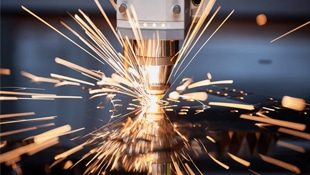
高精度
高精度
Laser cutting achieves extremely precise cuts with sharp edges and tight tolerances.
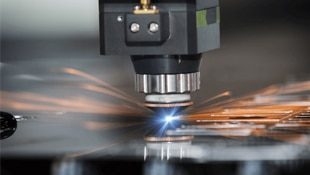
汎用性
汎用性
Capable of cutting a wide range of materials including metals, plastics, wood, and more.
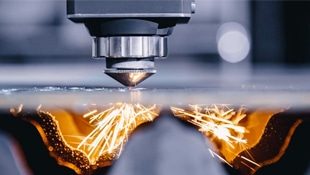
非接触切断
非接触切断
Laser cutting is a non-contact process, minimizing the risk of material damage.

材料の無駄を最小限に抑える
材料の無駄を最小限に抑える
Produces narrow kerf widths, reducing material waste and costs.
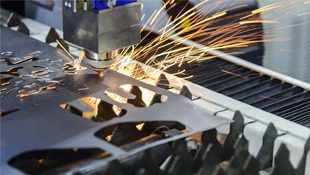
High-Speed Cutting
High-Speed Cutting
Enables rapid production of parts and components, ideal for mass production.
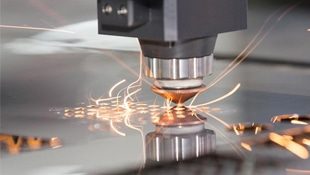
Flexibility and Customization
Flexibility and Customization
Allows for the production of complex shapes and customization with ease.

Reduced Tooling Costs
Reduced Tooling Costs
Eliminates the need for specialized tools, reducing setup time and costs.

Automation and Integration
Automation and Integration
Can be integrated with robotic systems for lights-out manufacturing, increasing productivity and efficiency.
よくある質問
What Is A Laser Cutting Machine?
A laser cutting machine is a tool that uses a high-powered laser beam to cut through various materials with precision. It’s widely used in manufacturing, fabrication, and various industries for cutting materials like metal, wood, plastic, fabric, glass, and more.
The basic principle involves focusing a concentrated beam of light energy onto a small area of the material, which heats it rapidly, causing it to melt, burn, or vaporize, depending on the material and the laser’s parameters. This process creates a clean and precise cut, often with minimal waste and a high degree of accuracy.
Laser cutting machines come in different types and configurations, including CO2 lasers, fiber lasers, and neodymium (Nd) lasers, each suited for different materials and applications. They can be used for cutting intricate shapes, making precise cuts, engraving, and marking materials, offering versatility and efficiency in various manufacturing processes.
What Can A Laser Cutting Machine Do?
The laser-cutting machine can perform a wide range of tasks across various industries and applications. Here are some of the primary capabilities:
- Cutting: Laser cutting machines can cut through various materials with high precision, including metals (such as steel, aluminum, and brass), wood, plastics, acrylics, rubber, fabrics, leather, and more. They can create intricate shapes, straight lines, and curves with smooth edges.
- Engraving and Marking: Laser-cutting machines can engrave or mark surfaces by removing material or changing their appearance through controlled laser energy. This is commonly used for adding serial numbers, logos, text, graphics, or decorative patterns onto items made of metal, wood, glass, plastics, and other materials.
- Prototyping and Rapid Manufacturing: Laser cutting is often used in prototyping and rapid manufacturing processes, allowing for quick production of small batches or one-off parts. It enables designers and engineers to test designs, iterate quickly, and bring products to market faster.
- Customization and Personalization: Laser cutting machines are ideal for customization and personalization tasks, such as creating bespoke signage, promotional items, gifts, jewelry, architectural models, and decorative elements. They offer flexibility in design and can accommodate individual preferences and unique requirements.
- Precision Cutting: Laser technology provides high precision and accuracy, making it suitable for cutting intricate shapes, fine details, and small features. This precision is valuable in industries like electronics, aerospace, medical devices, and microfabrication.
- Material Processing: Laser-cutting machines can process a wide range of materials with varying thicknesses, textures, and properties. They can cut through thick metals for industrial applications or delicately etch delicate materials for artistic purposes.
- Automation and Integration: Laser cutting systems can be integrated into automated production lines and CNC (Computer Numerical Control) systems, allowing for high-volume production with minimal human intervention. This automation enhances efficiency, consistency, and productivity in manufacturing operations.
What Is The Price Of A Laser Cutting Machine?
The price of a laser cutting machine can vary widely depending on several factors, including the machine’s size, power, capabilities, brand, and additional features. Here’s a rough breakdown of the price range you might expect:
- Entry-level desktop or hobbyist machines: These smaller machines are typically designed for light-duty cutting and engraving tasks on materials like wood, acrylic, and leather. Prices for entry-level machines can start from a few hundred dollars to a few thousand dollars.
- Mid-range machines: These machines offer higher power and larger cutting areas, making them suitable for more demanding applications in small businesses, workshops, and educational institutions. Prices for mid-range machines can range from several thousand dollars to tens of thousands of dollars.
- Industrial-grade machines: These high-end machines are designed for heavy-duty cutting and engraving tasks in large-scale manufacturing facilities and industrial settings. They offer advanced features, higher precision, and faster cutting speeds. Prices for industrial-grade machines can range from tens of thousands of dollars to several hundred thousand dollars or more, depending on the specifications and customization options.
How Thick Can A Laser Cut?
The thickness that a laser can cut depends on several factors, including the type of material being cut, the power and type of laser used, the focal length of the laser lens, and the quality of the laser-cutting machine. Here’s a general guideline for the maximum cutting thickness for some common materials:
- Metal: Laser cutting is commonly used for thin to medium thicknesses of metals. Fiber lasers are particularly well-suited for cutting metals such as steel, stainless steel, and aluminum. Generally, fiber lasers can cut through metal sheets ranging from a fraction of a millimeter (for thin metals) up to several centimeters thick (for thicker materials), depending on the laser power and material properties.
- Wood: Laser cutting is highly effective for cutting various types of wood, including plywood, MDF (medium-density fiberboard), and solid wood. The thickness that a laser can cut through wood depends on factors such as the wood density, the type of wood, and the laser power. In general, lasers can cut through wood up to several centimeters thick, with thicker cuts achievable for softer woods.
- Plastic: Laser cutting is commonly used for cutting acrylic, polycarbonate, PVC, and other types of plastic materials. The thickness that a laser can cut through plastic depends on factors such as the material’s composition, density, and melting point. In general, lasers can cut through plastic sheets ranging from fractions of a millimeter to several centimeters thick.
- Fabric and Textiles: Laser cutting is widely used in the textile industry for cutting fabrics, leather, and other soft materials. The thickness that a laser can cut through fabric depends on factors such as the material’s density, composition, and weave. In general, lasers can cut through fabric and textiles ranging from fractions of a millimeter to several millimeters thick.
What Are The Dangers Of Laser Cutting?
Laser cutting can be a safe and efficient process when proper precautions are taken, but there are several potential hazards associated with laser cutting that operators and those working nearby should be aware of:
- Eye and Skin Hazards: The intense light produced by lasers, especially high-powered lasers, can cause severe eye injuries if proper eye protection is not worn. Direct exposure to the laser beam or even reflected beams can cause burns to the eyes and skin. Operators and nearby personnel should always wear appropriate laser safety goggles and clothing to protect against these hazards.
- Inhalation of Fumes and Particles: Laser cutting can produce fumes, gases, and fine particles when cutting certain materials, especially plastics, wood, and metals. These fumes and particles may contain hazardous substances such as volatile organic compounds (VOCs), metal fumes, and fine dust particles. Adequate ventilation systems, such as fume extractors or local exhaust ventilation, should be used to remove these contaminants from the work area and protect operators’ respiratory health.
- Fire and Combustion Hazards: Laser cutting produces a concentrated beam of intense heat, which can ignite flammable materials such as paper, cardboard, fabric, and certain types of plastics. Additionally, sparks and molten debris generated during the cutting process can pose a fire risk if they come into contact with combustible materials nearby. Proper fire safety measures, such as fire extinguishers, spark guards, and fire-resistant barriers, should be in place to minimize the risk of fires.
- Electrical Hazards: Laser cutting machines use high-voltage electrical systems to generate and control the laser beam. Improper handling or maintenance of electrical components can result in electric shocks, electrical burns, or other electrical hazards. Operators should follow proper lockout/tagout procedures when servicing or repairing laser-cutting equipment to prevent accidental contact with live electrical parts.
- Mechanical Hazards: Laser cutting machines typically have moving parts such as motors, belts, pulleys, and cutting heads, which can pose crushing, entanglement, or impact hazards if not properly guarded or maintained. Operators should be trained in safe operating procedures and use machine guards and safety interlocks to prevent accidental contact with moving parts.
Is Laser Cutting Cheaper Than Waterjet?
Determining whether laser cutting is cheaper than waterjet cutting depends on several factors, including the specific application, the material being cut, desired quality, and project requirements. Here’s a comparison of some key factors to consider:
- Material Versatility: Laser cutting is well-suited for cutting a wide range of materials, including metals, plastics, wood, and more. However, it may struggle with materials that are highly reflective or conductive, such as copper and brass. On the other hand, waterjet cutting can cut through virtually any material, including metals, ceramics, stone, glass, and composites, making it more versatile in certain applications.
- Speed and Efficiency: Laser cutting is generally faster than waterjet cutting, especially for thin to medium-thickness materials. Lasers can achieve high cutting speeds and are well-suited for producing intricate shapes and fine details with high precision. Waterjet cutting, while slower than lasers, excels in cutting thicker materials and is often preferred for applications where precision is less critical or where heat-affected zones are a concern.
- Operating Costs: Laser cutting typically has lower operating costs compared to waterjet cutting in terms of energy consumption, maintenance, and consumables. Laser cutting machines have lower power requirements and can operate with minimal consumables such as assist gases (e.g., nitrogen or oxygen). Waterjet cutting, on the other hand, requires a significant amount of water and abrasive media, which can add to operating costs.
- Initial Investment: The initial investment for a laser cutting machine is generally lower than that of a waterjet cutting machine, especially for entry-level or mid-range models. Laser-cutting machines are available in a wide range of sizes and configurations to suit different budgets and applications. Waterjet cutting machines tend to be more expensive upfront due to the complex high-pressure water delivery system and abrasive handling equipment required.
- Maintenance Requirements: Laser cutting machines typically have lower maintenance requirements compared to waterjet cutting machines. Waterjet systems require regular maintenance of high-pressure components, including pumps, valves, and seals, to ensure optimal performance and prevent downtime. Laser cutting machines may require periodic maintenance of laser tubes, optics, and cutting heads, but they generally have fewer moving parts and are easier to maintain.
What Is The Difference Between CNC Cutting And Laser Cutting?
CNC cutting and laser cutting are both methods used to cut materials with precision, but they utilize different technologies and processes. Here are the main differences between CNC cutting and laser cutting:
- Technology
- CNC Cutting: CNC (Computer Numerical Control) cutting refers to the process of cutting materials using a computer-controlled machine tool. These machines can include various types of cutting tools, such as saws, routers, plasma cutting machines, and waterjets, among others. CNC cutting machines are versatile and can be used for cutting, drilling milling, and other machining operations.
- Laser Cutting: Laser cutting uses a high-powered laser beam to cut through materials with precision. The laser beam is generated by a laser resonator and directed through a series of mirrors or fiber optics to the cutting head, where it is focused on the workpiece. Laser-cutting machines are capable of cutting a wide range of materials, including metals, plastics, wood, and more, with high accuracy and speed.
- 切断方法
- CNC Cutting: CNC cutting machines use mechanical tools, such as blades, drills, or cutting heads, to physically remove material from the workpiece. The cutting tool is controlled by a computer program that specifies the cutting path and parameters.
- Laser Cutting: Laser cutting machines use a focused laser beam to melt, burn, or vaporize material along the cutting path. The intense heat generated by the laser beam results in a clean and precise cut, with minimal material deformation or tool wear.
- 精度と精度
- CNC Cutting: CNC cutting machines can achieve high levels of precision and accuracy, depending on the type of cutting tool and the machine’s capabilities. However, the cutting accuracy may be limited by factors such as tool deflection, wear, and material properties.
- Laser Cutting: Laser cutting offers exceptional precision and accuracy, with the ability to cut intricate shapes, fine details, and tight tolerances. The laser beam can be focused to a very small spot size, allowing for precise control over the cutting process.
- 材質の適合性
- CNC Cutting: CNC cutting machines are versatile and can be used to cut a wide range of materials, including metals, plastics, wood, composites, and more. The choice of cutting tool and cutting parameters depends on the material being processed.
- Laser Cutting: Laser cutting is highly versatile and can cut through various materials, including metals, plastics, wood, acrylic, leather, fabric, and more. However, the suitability of laser cutting for specific materials depends on factors such as material thickness, composition, and optical properties.
What Materials Cannot Be Cut By A Laser Cutting Machine?
While laser cutting is a versatile and widely used method for cutting various materials, some materials cannot be effectively cut or are not suitable for laser cutting due to their properties. Here are some examples:
- Reflective Materials: Highly reflective materials such as copper, brass, and aluminum can reflect the laser beam instead of absorbing it, making it challenging to cut them effectively. The reflective nature of these materials can cause damage to the laser optics and reduce cutting efficiency. While it’s possible to cut thin sheets of reflective metals with specialized lasers, thicker or highly reflective materials may require alternative cutting methods.
- Transparent Materials: Transparent materials such as glass and certain plastics are not suitable for laser cutting because the laser beam passes through them without significant absorption or cutting action. Instead of cutting, the laser beam may cause melting or charring on the material’s surface. However, lasers can be used for engraving or marking transparent materials by creating surface patterns or markings.
- PVC and Vinyl: Polyvinyl chloride (PVC) and vinyl materials are not recommended for laser cutting due to the release of toxic gases and corrosive byproducts when exposed to the high temperatures generated by the laser beam. Cutting PVC or vinyl with a laser can produce harmful fumes and damage the laser-cutting machine’s optics and components. It’s safer to use alternative cutting methods for these materials.
- Certain Ceramics and Stones: Some ceramics and natural stones, such as granite and marble, are challenging to cut with lasers due to their hardness and composition. While lasers can engrave or etch these materials, cutting them with lasers may require specialized equipment and techniques. Waterjet cutting is often preferred for cutting hard and brittle materials like ceramics and stones.
- Certain Composites and Laminates: Some composite materials and laminates contain layers of different materials bonded together, making them difficult to cut with lasers. The varying material properties and adhesives used in composites and laminates can result in inconsistent cutting quality and may damage the laser cutting machine’s optics. Alternative cutting methods such as CNC milling or waterjet cutting may be more suitable for these materials.
レーザー切断の欠点は何ですか?
While laser cutting offers many advantages, there are also some disadvantages associated with the process. Here are some common drawbacks of laser cutting:
- High Initial Investment: Laser-cutting machines can be expensive to purchase, especially high-powered industrial-grade models. The initial investment includes the cost of the machine itself, as well as installation, training, and additional accessories or software.
- Limited Thickness for Certain Materials: While laser cutting is suitable for cutting a wide range of materials, including metals, plastics, and wood, there may be limitations on the thickness of certain materials that can be effectively cut. Thicker materials may require multiple passes or alternative cutting methods.
- Material Limitations: Laser cutting may not be suitable for all materials. For example, highly reflective metals like copper and brass can be challenging to cut due to the reflection of the laser beam. Similarly, certain materials like PVC and vinyl produce toxic fumes when cut with lasers, making them unsuitable for laser cutting.
- Heat-Affected Zone: Laser cutting generates heat, which can lead to a heat-affected zone (HAZ) along the cut edge of the material. In some cases, this heat can cause undesirable changes in material properties, such as melting, warping, or discoloration, particularly in thermally sensitive materials.
- The Complexity of Setup and Maintenance: Laser cutting machines require regular maintenance to ensure optimal performance and safety. Maintenance tasks may include cleaning optics, replacing consumable parts (such as laser tubes and lenses), and calibrating the machine. Additionally, setting up the machine for a new job may require programming the cutting path, adjusting parameters, and testing to achieve the desired results.
- Safety Hazards: Laser cutting poses several safety hazards, including exposure to high-intensity light, fumes, and hazardous materials. Operators must wear appropriate personal protective equipment (PPE) and follow safety protocols to prevent injuries. Additionally, laser-cutting machines should be equipped with safety features such as interlocks, enclosures, and exhaust systems to minimize risks.
- Environmental Considerations: Laser cutting can generate fumes, gases, and waste materials, which may require proper ventilation and waste disposal procedures to comply with environmental regulations. Additionally, some materials used in laser cutting, such as acrylic, emit harmful gases when cut, requiring additional measures to ensure workplace safety.
レーザー ソリューションを入手する
お客様の要件に応じてデザインをカスタマイズできます。お客様の要件をお知らせいただくだけで、当社のエンジニアが最短時間でターンキー ソリューションを提供します。当社のレーザー機器の価格は非常に競争力があります。無料の見積もりについては、お問い合わせください。その他のレーザー機器関連のサービスが必要な場合は、お問い合わせください。

